非谓语动词用法归纳语法)
- 格式:docx
- 大小:21.66 KB
- 文档页数:8
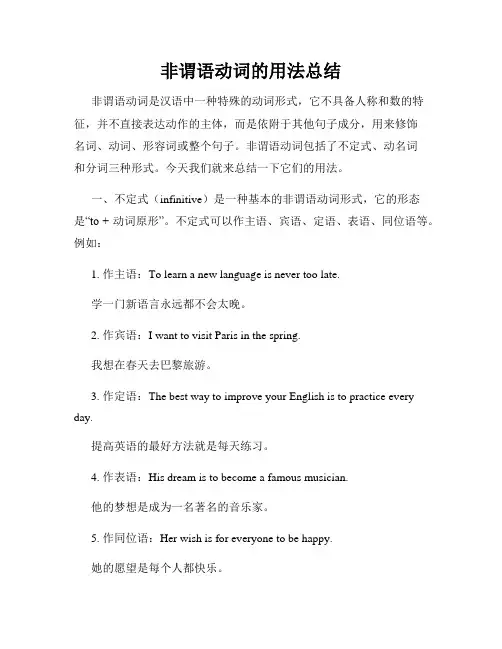
非谓语动词的用法总结非谓语动词是汉语中一种特殊的动词形式,它不具备人称和数的特征,并不直接表达动作的主体,而是依附于其他句子成分,用来修饰名词、动词、形容词或整个句子。
非谓语动词包括了不定式、动名词和分词三种形式。
今天我们就来总结一下它们的用法。
一、不定式(infinitive)是一种基本的非谓语动词形式,它的形态是“to + 动词原形”。
不定式可以作主语、宾语、定语、表语、同位语等。
例如:1. 作主语:To learn a new language is never too late.学一门新语言永远都不会太晚。
2. 作宾语:I want to visit Paris in the spring.我想在春天去巴黎旅游。
3. 作定语:The best way to improve your English is to practice every day.提高英语的最好方法就是每天练习。
4. 作表语:His dream is to become a famous musician.他的梦想是成为一名著名的音乐家。
5. 作同位语:Her wish is for everyone to be happy.她的愿望是每个人都快乐。
二、动名词(gerund)是名词化的动词,它的形态是动词的现在分词形式(V-ing),可以作主语、宾语、定语、表语等。
例如:1. 作主语:Swimming is good for your health.游泳对身体健康有好处。
2. 作宾语:He enjoys playing basketball in his free time.他喜欢在空闲时间打篮球。
3. 作定语:I have a meeting with my boss this afternoon.我今天下午有个与老板的会议。
4. 作表语:Her favorite activity is dancing.她最喜欢的活动是跳舞。
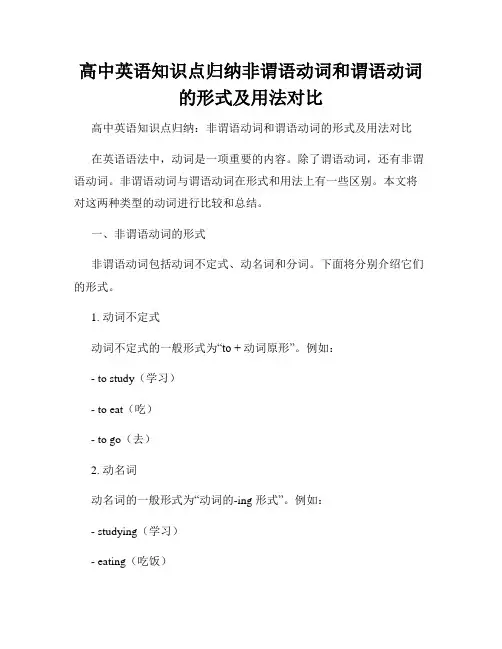
高中英语知识点归纳非谓语动词和谓语动词的形式及用法对比高中英语知识点归纳:非谓语动词和谓语动词的形式及用法对比在英语语法中,动词是一项重要的内容。
除了谓语动词,还有非谓语动词。
非谓语动词与谓语动词在形式和用法上有一些区别。
本文将对这两种类型的动词进行比较和总结。
一、非谓语动词的形式非谓语动词包括动词不定式、动名词和分词。
下面将分别介绍它们的形式。
1. 动词不定式动词不定式的一般形式为“to + 动词原形”。
例如:- to study(学习)- to eat(吃)- to go(去)2. 动名词动名词的一般形式为“动词的-ing 形式”。
例如:- studying(学习)- eating(吃饭)- going(去)3. 分词分词有两种形式:现在分词(-ing 形式)和过去分词(-ed 或 -en 形式)。
例如:- studying(正在学习)- eaten(被吃掉的)- broken(被打破)二、非谓语动词的用法非谓语动词在句子中可以充当多种不同的成分,下面将分别介绍它们的用法。
1. 动词不定式的用法- 作主语:To study is important.(学习很重要。
)- 作宾语:I want to eat an apple.(我想吃一个苹果。
)- 作补语:His goal is to win the championship.(他的目标是赢得冠军。
)- 作定语:We need a pen to write.(我们需要一支笔来写字。
)- 作状语:She woke up early to catch the train.(她早早醒来以赶上火车。
)2. 动名词的用法- 作主语:Studying is important.(学习很重要。
)- 作宾语:I enjoy listening to music.(我喜欢听音乐。
)- 作补语:Her hobby is singing.(她的爱好是唱歌。
)- 作定语:I saw a flying bird.(我看到一只在飞的鸟。
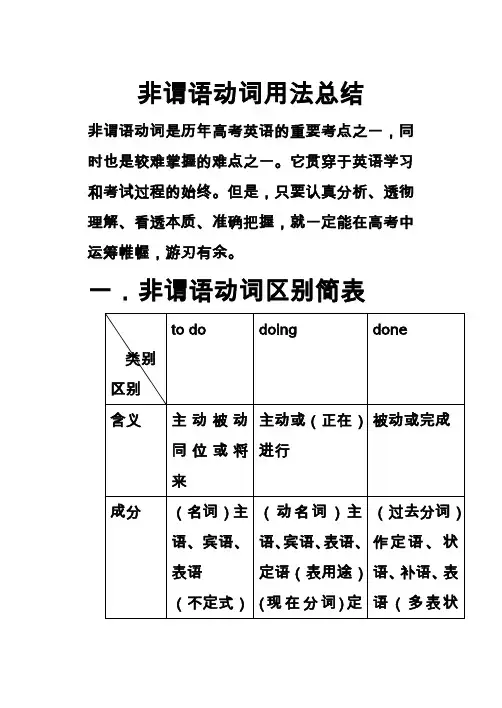
非谓语动词用法总结非谓语动词是历年高考英语的重要考点之一,同时也是较难掌握的难点之一。
它贯穿于英语学习和考试过程的始终。
但是,只要认真分析、透彻理解、看透本质、准确把握,就一定能在高考中运筹帷幄,游刃有余。
一.非谓语动词区别简表二.不定式的用法不定式不可作谓语,但它可以有自己的宾语、状语,构成不定式短语,在句中可以作主语、宾语、表语、定语(表用途)、状语或补足语。
高考对不定式的考查主要有不定式的时态、语态、作用、否定、省略、连词+不定式等。
作主语不定式作主语表示具体的动作,通常指一件已知的事或目的。
不定式作主语时,谓语动词用单数。
eg:To say is a thing,to do is another.(说是一回事,做是另外一回事。
)(2)不定式短语较长时,通常放在谓语之后,用it作形式主语。
eg:①It is important to learn English well.(学好英语是重要的。
)②It is necessary for us to do the job well.(我们做好这项工作是必要的。
)③It is a great honor to be invited to give a speech here.(被邀请在这儿发表演讲是一个极大的荣幸。
)2.作宾语(1)常只用不定式作宾语的动词有:want,wish,hope,long,expect,desire,intend,decid e,ask,promise,aim,offer,agree,plan,learn,choos e,refuse,fail,manage,pretend等。
eg:①He refused to help me.(他拒绝帮助我.)②She has agreed to come tomorrow.(他已同意明天来.)(2) 不定式较长时,作宾语,也可用it代替,放在后面。
eg;I find it difficult to do the job well.(3) “特殊疑问词﹢不定式to do结构”具有名词特征,可作宾语。
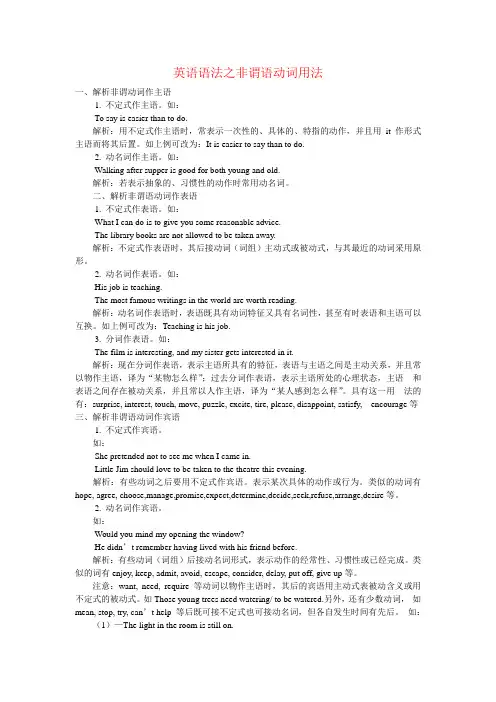
英语语法之非谓语动词用法一、解析非谓动词作主语1. 不定式作主语。
如:To say is easier than to do.解析:用不定式作主语时,常表示一次性的、具体的、特指的动作,并且用it作形式主语而将其后置。
如上例可改为:It is easier to say than to do.2. 动名词作主语。
如:Walking after supper is good for both young and old.解析:若表示抽象的、习惯性的动作时常用动名词。
二、解析非谓语动词作表语1. 不定式作表语。
如:What I can do is to give you some reasonable advice.The library books are not allowed to be taken away.解析:不定式作表语时,其后接动词(词组)主动式或被动式,与其最近的动词采用原形。
2. 动名词作表语。
如:His job is teaching.The most famous writings in the world are worth reading.解析:动名词作表语时,表语既具有动词特征又具有名词性,甚至有时表语和主语可以互换。
如上例可改为:Teaching is his job.3. 分词作表语。
如:The film is interesting, and my sister gets interested in it.解析:现在分词作表语,表示主语所具有的特征,表语与主语之间是主动关系,并且常以物作主语,译为“某物怎么样”;过去分词作表语,表示主语所处的心理状态,主语和表语之间存在被动关系,并且常以人作主语,译为“某人感到怎么样”。
具有这一用法的有:surprise, interest, touch, move, puzzle, excite, tire, please, disappoint, satisfy, encourage等三、解析非谓语动词作宾语1. 不定式作宾语。

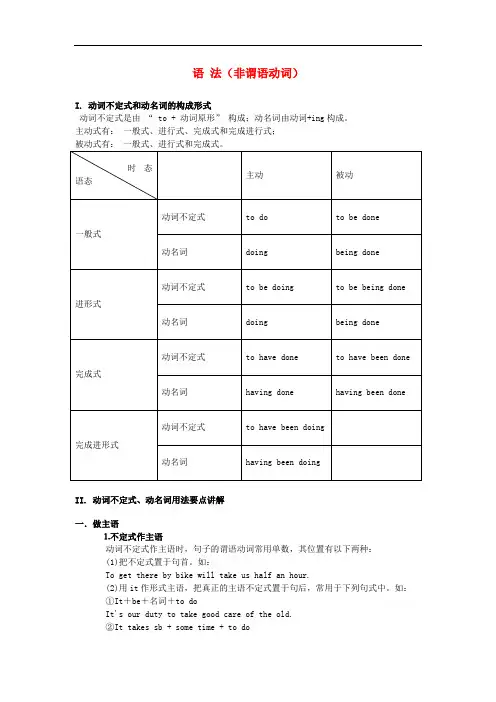
语法(非谓语动词)I. 动词不定式和动名词的构成形式动词不定式是由“ to + 动词原形”构成;动名词由动词+ing构成。
主动式有:一般式、进行式、完成式和完成进行式;II. 动词不定式、动名词用法要点讲解一.做主语⒈不定式作主语动词不定式作主语时,句子的谓语动词常用单数,其位置有以下两种:(1)把不定式置于句首。
如:To get there by bike will take us half an hour.(2)用it作形式主语,把真正的主语不定式置于句后,常用于下列句式中。
如:①It+be+名词+to doIt's our duty to take good care of the old.②It takes sb + some time + to doHow long did it take you to finish the work?③It+be+形容词+for sb+to doIt is difficult for us to finish writing the composition in a quarter of an hour.④It+be+形容词+of sb+to doIt is stupid of you to write down everything the teacher says.⑤It seems(appears)+形容词+to doIt seemed impossible to save money.在句型③中,常用表示客观情况的形容词,如:difficult, easy, hard, important, impossible, necessary 等;在句型④中,常用careless,clever,good,foolish,honest,kind,lazy,nice,right,silly,stupid,wise等表示赞扬或批评的词。
在不定式前的sb,可看作其逻辑主语。
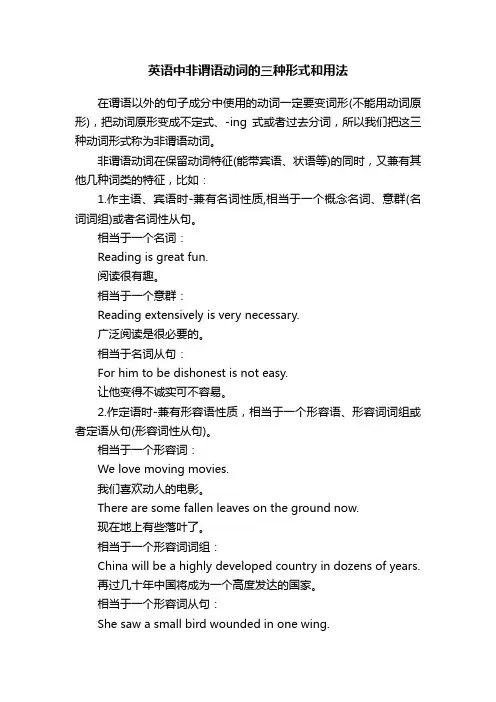
英语中非谓语动词的三种形式和用法在谓语以外的句子成分中使用的动词一定要变词形(不能用动词原形),把动词原形变成不定式、-ing式或者过去分词,所以我们把这三种动词形式称为非谓语动词。
非谓语动词在保留动词特征(能带宾语、状语等)的同时,又兼有其他几种词类的特征,比如:1.作主语、宾语时-兼有名词性质,相当于一个概念名词、意群(名词词组)或者名词性从句。
相当于一个名词:Reading is great fun.阅读很有趣。
相当于一个意群:Reading extensively is very necessary.广泛阅读是很必要的。
相当于名词从句:For him to be dishonest is not easy.让他变得不诚实可不容易。
2.作定语时-兼有形容语性质,相当于一个形容语、形容词词组或者定语从句(形容词性从句)。
相当于一个形容词:We love moving movies.我们喜欢动人的电影。
There are some fallen leaves on the ground now.现在地上有些落叶了。
相当于一个形容词词组:China will be a highly developed country in dozens of years.再过几十年中国将成为一个高度发达的国家。
相当于一个形容词从句:She saw a small bird wounded in one wing.她看见一只有个翅膀受伤的小鸟。
作状语时-兼有副词性质,相当于一个副词、副词词组或者副词从句(状语从句)。
相当于一个副词:She was happy to come.她很高兴地来了。
相当于一个副词词组:To be frank (frankly),I disagree with you.坦率地说,我不同意你的话。
相当于一个副词从句:Being late for class (=Because he was late for class), Tom was afraid to enter the classroom.由于迟到,汤姆不敢进教室。
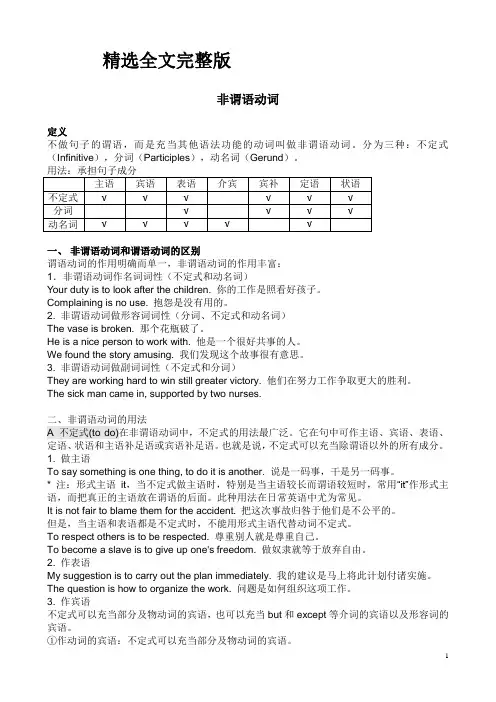
精选全文完整版非谓语动词定义不做句子的谓语,而是充当其他语法功能的动词叫做非谓语动词。
分为三种:不定式(Infinitive),分词(Participles),动名词(Gerund)。
一、非谓语动词和谓语动词的区别谓语动词的作用明确而单一,非谓语动词的作用丰富:1.非谓语动词作名词词性(不定式和动名词)Your duty is to look after the children. 你的工作是照看好孩子。
Complaining is no use. 抱怨是没有用的。
2. 非谓语动词做形容词词性(分词、不定式和动名词)The vase is broken. 那个花瓶破了。
He is a nice person to work with. 他是一个很好共事的人。
We found the story amusing. 我们发现这个故事很有意思。
3. 非谓语动词做副词词性(不定式和分词)They are working hard to win still greater victory. 他们在努力工作争取更大的胜利。
The sick man came in, supported by two nurses.二、非谓语动词的用法A 不定式(to do)在非谓语动词中,不定式的用法最广泛。
它在句中可作主语、宾语、表语、定语、状语和主语补足语或宾语补足语。
也就是说,不定式可以充当除谓语以外的所有成分。
1. 做主语To say something is one thing, to do it is another. 说是一码事,干是另一码事。
* 注:形式主语it,当不定式做主语时,特别是当主语较长而谓语较短时,常用“it”作形式主语,而把真正的主语放在谓语的后面。
此种用法在日常英语中尤为常见。
It is not fair to blame them for the accident. 把这次事故归咎于他们是不公平的。
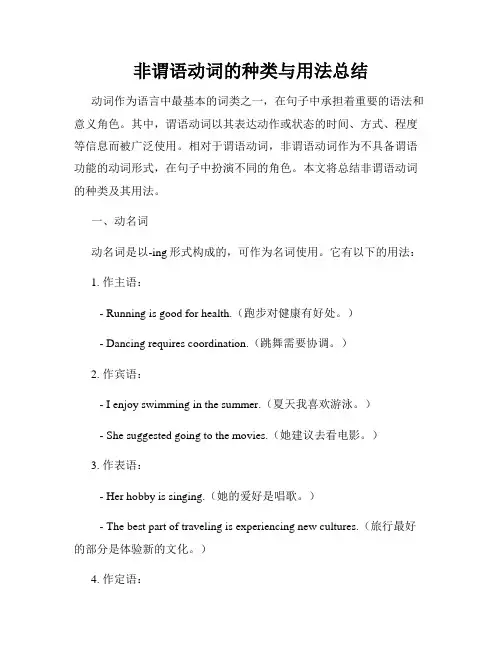
非谓语动词的种类与用法总结动词作为语言中最基本的词类之一,在句子中承担着重要的语法和意义角色。
其中,谓语动词以其表达动作或状态的时间、方式、程度等信息而被广泛使用。
相对于谓语动词,非谓语动词作为不具备谓语功能的动词形式,在句子中扮演不同的角色。
本文将总结非谓语动词的种类及其用法。
一、动名词动名词是以-ing形式构成的,可作为名词使用。
它有以下的用法:1. 作主语:- Running is good for health.(跑步对健康有好处。
)- Dancing requires coordination.(跳舞需要协调。
)2. 作宾语:- I enjoy swimming in the summer.(夏天我喜欢游泳。
)- She suggested going to the movies.(她建议去看电影。
)3. 作表语:- Her hobby is singing.(她的爱好是唱歌。
)- The best part of traveling is experiencing new cultures.(旅行最好的部分是体验新的文化。
)4. 作定语:- The crying baby kept me awake all night.(那个哭闹的婴儿整晚让我没法入睡。
)- I saw a running dog in the street.(我在街上看到一只跑步的狗。
)二、不定式不定式是以to加动词原形构成的,可作为名词、形容词或副词使用。
它有以下的用法:1. 作主语:- To learn a new language requires patience.(学习一门新语言需要耐心。
)- To travel is my dream.(旅行是我的梦想。
)2. 作宾语:- I want to buy a new car.(我想买一辆新车。
)- He needs to finish the report by tomorrow.(他需要在明天之前完成报告。
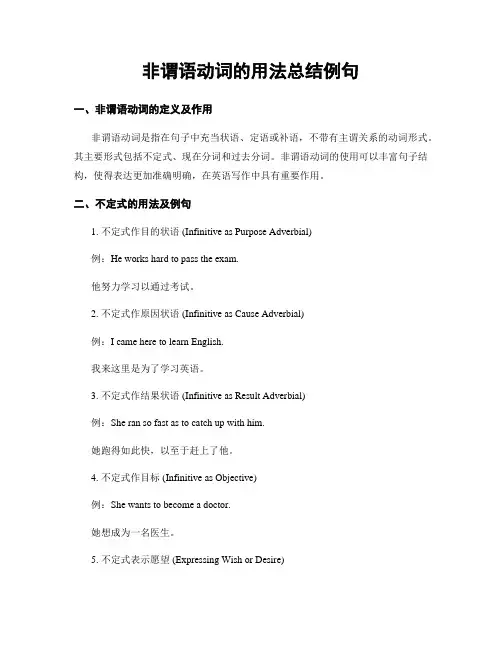
非谓语动词的用法总结例句一、非谓语动词的定义及作用非谓语动词是指在句子中充当状语、定语或补语,不带有主谓关系的动词形式。
其主要形式包括不定式、现在分词和过去分词。
非谓语动词的使用可以丰富句子结构,使得表达更加准确明确,在英语写作中具有重要作用。
二、不定式的用法及例句1. 不定式作目的状语 (Infinitive as Purpose Adverbial)例:He works hard to pass the exam.他努力学习以通过考试。
2. 不定式作原因状语 (Infinitive as Cause Adverbial)例:I came here to learn English.我来这里是为了学习英语。
3. 不定式作结果状语 (Infinitive as Result Adverbial)例:She ran so fast as to catch up with him.她跑得如此快,以至于赶上了他。
4. 不定式作目标 (Infinitive as Objective)例:She wants to become a doctor.她想成为一名医生。
5. 不定式表示愿望 (Expressing Wish or Desire)例:I hope to see you again soon.我希望很快能再见到你。
6. 不定式作宾补 (Infinitive as Object Complement)例:We elected her to be our leader.我们选她作为我们的领导。
三、现在分词的用法及例句1. 现在分词作状语 (Present Participle as Adverbial)例:Walking in the park, she met her old friend.她在公园里散步时遇到了她的老朋友。
2. 现在分词作定语 (Present Participle as Attributive)例:He gave me an interesting book written by himself.他给了我一本有趣的自己写的书。
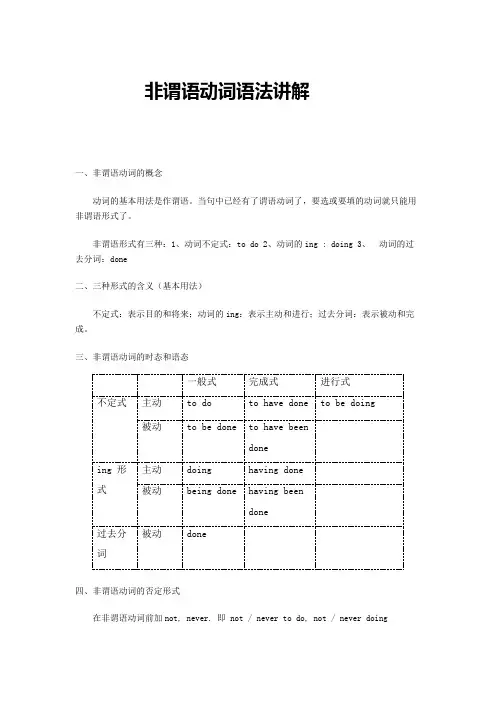
非谓语动词语法讲解一、非谓语动词的概念动词的基本用法是作谓语。
当句中已经有了谓语动词了,要选或要填的动词就只能用非谓语形式了。
非谓语形式有三种:1、动词不定式:to do 2、动词的ing : doing 3、动词的过去分词:done二、三种形式的含义(基本用法)不定式:表示目的和将来;动词的ing:表示主动和进行;过去分词:表示被动和完成。
三、非谓语动词的时态和语态一般式完成式进行式不定式主动to do to have done to be doing被动to be done to have beendoneing 形式主动doing having done 被动being done having beendone过去分词被动done四、非谓语动词的否定形式在非谓语动词前加not, never. 即 not / never to do, not / never doing五、非谓语动词的复合结构不定式的复合结构:for / of sb. to do sth.动词 ing 形式的复合结构:宾格或所有格+doing (-ing 形式作主语时,用的所有格+doing)六、非谓语动词的做题步骤1、判定是否用非谓语形式。
方法:看看句子中是否已有了谓语动词了2、找非谓语动词的逻辑主语。
方法:非谓语动词的逻辑主语一般是句子的主语。
3、判断主被动关系。
方法:非谓语动词与其逻辑主语的主动还是被动关系。
4、判断时间关系。
方法:分析句子,看看非谓语动词所表示的动作发生在谓语动作之前、之后还是同时。
之前常用 done; 之后常用to do; 同时常用doing.学习非谓语形式时,建议把三种形式一起来比较学习,会更加有效一些。
七、非谓语动词作主语和表语的比较1、不定式和动名词作主语和表语a. 不定式表示一次性的、具体的动词。
动词ing 常表示一般的、泛指的或习惯性的动作。
如:________ is a good form of exercise for both young and old.A. The walkB. WalkingC. To walkD. Walk(分析) a good form 暗示泛指一般的行为,用动名词作主语,选 Bb. 不定式作主语时,常用it 作形式主语,即用句型:It is + adj. / n. + (for / of sb. ) to do sth.It’s important for us to learn English well.It’s kind of you to help us.注意:下面几个句型是用动名词:It’s no good / use doing sth.It’s usel ess doing sth.There is no need to do sth.2、不定式、动名词、分词作表语的比较1、不定式、动名词作表语,.表示主语的内容。
(完整word版)非谓语动词的用法归纳(word版可编辑修改)编辑整理:尊敬的读者朋友们:这里是精品文档编辑中心,本文档内容是由我和我的同事精心编辑整理后发布的,发布之前我们对文中内容进行仔细校对,但是难免会有疏漏的地方,但是任然希望((完整word版)非谓语动词的用法归纳(word版可编辑修改))的内容能够给您的工作和学习带来便利。
同时也真诚的希望收到您的建议和反馈,这将是我们进步的源泉,前进的动力。
本文可编辑可修改,如果觉得对您有帮助请收藏以便随时查阅,最后祝您生活愉快业绩进步,以下为(完整word版)非谓语动词的用法归纳(word版可编辑修改)的全部内容。
非谓语动词Non-Finite Verb I 非谓语的三种形式II 本章要点I非谓语语法点分述一、不定式 to do1.不定式结构作主语➢To see is to believe.➢It is better to see something once than to hear about it a hundred times.a.在很多情况下,特别是在口语中,常采用先行it代替主语,而把不定式后置:➢It’s a great pleasure to be here.➢It is not an easy thing to master a language。
★区分用法★1)直接用不定式做主语的句子显得更加正式。
2)如主语和表语都是to do,则只能采用第一种形式。
➢对敌人仁慈就是对人民残忍。
3)如是疑问句或感叹句,则只能采用第二种形式.➢What is it like to be there?➢What a joy it was to read Barak’s book!b.用It is+形容词作表语时,由于逻辑主语不同导致的for和of的区别.(1)for sb。
句型中的形容词一般为表示事物的特征特点,表示客观形式的形容词,如:difficult, interesting, easy, impossible等..(2)of sb.句型中的形容词一般为表示性格、品德、心智能力,表示主观感情或态度的形容词,如:good, kind, nice, clever, foolish等。
非谓语动词的用法详解非谓语动词是指在句子中不作谓语,通常以动词的形式出现,但不带有人称和时态的特征。
非谓语动词分为动名词、不定式和分词三种形式。
它们在句子中可以作主语、宾语、定语等,并且能够起到丰富表达和修饰句子的作用。
下面将详细介绍非谓语动词的用法。
一、动名词的用法动名词是将动词变为名词形式,常以-ing结尾。
动名词可以单独作主语、宾语或表语。
例如:1. Smoking is bad for your health.(吸烟对健康有害。
)2. She enjoys swimming in the summer.(她喜欢在夏天游泳。
)3. His hobby is playing the piano.(他的爱好是弹钢琴。
)同时,动名词还可与一些动词连用,构成特定的短语或固定搭配。
例如:1. look forward to(期待)2. be good at(擅长)3. be interested in(对...感兴趣)4. give up(放弃)5. keep on(继续)动名词短语在句子中可充当主语、宾语、定语或表语等。
例如:1. Sleeping too much is bad for your health.(睡得太多对健康有害。
)2. I enjoy listening to music.(我喜欢听音乐。
)3. The girl sitting at the back is my sister.(坐在后面的女孩是我的妹妹。
)二、不定式的用法不定式是动词的一种形式,用to+动词原形表示。
不定式可以作主语、宾语、定语、表语等。
例如:1. To learn a new language requires patience.(学习一门新语言需要耐心。
)2. I want to buy a new car.(我想买一辆新车。
)3. The best way to improve your English is to practice more.(提高英语的最好方法就是多练习。
非谓语动词作定语的用法总结
非谓语动词是指不具有主谓结构的动词形式,包括不定式、动名词和分词。
在英语中,非谓语动词也可以用作定语,用来修饰名词或代词。
以下是非谓语动词作定语的用法总结:
1. 不定式作定语:
- 不定式作定语通常放在被修饰的名词之后。
例如:"an easy book to read"(一本容易阅读的书)。
- 不定式作定语可以用来表示目的、用途或结果。
例如:"a tool to fix the bike"(修理自行车的工具)。
2. 动名词作定语:
- 动名词作定语通常放在被修饰的名词之前。
例如:"the swimming pool"(游泳池)。
- 动名词作定语可以用来表示被修饰名词的用途、原因或特征。
例如:"a writing desk"(写字台)。
3. 分词作定语:
- 分词作定语可以是现在分词(-ing形式)或过去分词(-ed形式)。
- 现在分词作定语通常表示正在进行的动作或者被修饰名词的特征。
例如:"a smiling child"(笑着的孩子)。
- 过去分词作定语通常表示被修饰名词的状态或者受到的动作。
例如:"a broken window"(破碎的窗户)。
非谓语动词作定语的用法可以丰富句子,使其更加具体和生动。
熟练掌握这些用法可以帮助我们更好地表达和理解英语。
非谓语动词的用法总结一、非谓语动词概述非谓语动词是指不具备谓语性质的动词形式,它以独立于主谓结构的方式出现在句子中。
在英语中,非谓语动词包括不定式、现在分词和过去分词。
本文将总结非谓语动词的用法,并重点讨论其作为状语、定语和补足语的功能。
二、不定式的用法1. 作为目的状语:不定式常用来表示动作或状态的目的。
例如:“I went to the store to buy some groceries.”(我去商店买些杂货)2. 作为结果状语:不定式有时表示某个动作或状态发生的结果。
例如:“He worked hard to climb the mountain.”(他努力工作才成功登上山顶)3. 作为原因状语:不定式可以用来表示某个行为或状态发生的原因。
例如:“She stayed up late to finish her homework.”(她熬夜完成家庭作业)4. 作为条件状语:在条件句中,常使用"if"引导一个带有不定式的从句。
例如:“If you want to succeed, you must work hard.”(如果你想成功,就必须努力工作)5. 作为名词性质:不定式可以充当名词的角色,用来作主语、宾语、表语等。
例如:“To travel is my dream.”(旅行是我的梦想)6. 作为定语:不定式可以修饰名词或代词,起到定语的作用。
例如:“Thebook to read is on the shelf.”(要读的那本书在书架上)三、现在分词的用法1. 作为形容词:现在分词可用于描述一个正在进行或具有某种性质的人或事物。
例如:“She saw a crying baby in the park.”(她看到了公园里哭泣的婴儿)2. 作为状语:现在分词可以表示时间,原因,条件等意义。
例如:“Walking by the river, he felt relaxed.”(边走边看河流,他觉得很放松)3. 和系动词连用:现在分词可以和系动词连用,构成谓语部分。
非谓语动词的用法在英语语法中,掌握好动词的用法是最重要的,而非谓语动词又是动词中非常重要的一部分,由于它们内容多,有些用法相似,所以不好掌握,经常被混淆用错,下面通过列表比较的方式,分析非谓语动词的主要用法。
非谓语动词和谓语动词的相对时间关系1. 非谓语动词被动语态的意义三.非谓语动词的句法作用2. 非谓语动词作主语过 去 分 词相当于形容词说 明主语动作的性 质或状态,一般 后面带介词短 语,有些形容词 化的过去分词前 可加 very.有时可用 become ; get ;remain ; appear ; seem; fell; go; look 等动词He remained puzzled. He appeared satisfied with that.My work is finished. My watch is gone. 常见的过去分词有: 1) 常见带介词 about 分词:annoyed, concerned, excited, pleased, puzzled, shocked, worried 2) 常见带介词 at分词: amazed, amused, annoyed, astonished,delighted, disappointed, disgusted,displeased, dissatisfied, excited, offended, overjoyed, pleased, shocked, surprised, 3) 常见带介词 against 分词: arranged, prepared, irritated, arranged 4)常见带介词 for 分词: celebrated,concerned, destined, disqualified, noted, prepared, pressed, qualified. 5) 常见带介词 in 分词: absorbed, celebrated,concerned, disappointed, delighted, dressed, embarrassed, engaged, entangled, experienced, interested lost, 6) 常见带介词 on 分词: founded, based, bent, set 7) 常见带介词 to 分词: abandoned,accustomed, acquainted, addicted, adapted, committed, dedicated, destined, devoted, doomed, engaged, entitled, exposed, known, lost, opposed, related, inclined, married 8) 常见带介词 with 分词: annoyed, bored, concerned, delighted, disappointed, discontented, disgusted, displeased, dissatisfied, equipped, excited, occupied, obsessed, pleased, pressed, satisfied, socked, stunned, surrounded loaded,tormented, torture6.7.8.四. 非谓语动词的特殊形式五. 非谓语动词的否定形式英语中将来时的表示形式表示将要发生的动作和状态在英语中用将来时,将来时在英语中有多种表达形式,为了掌握它们的区别和用法,下面笔者对它们进行分类总结。
英语非谓语动词的用法总结英语非谓语动词的用法总结一、非谓语动词的定义非谓语动词是指不充当句子的谓语,而作为谓语动词的补语,或者修饰某一动词词组,从而起到补充完善句子的作用的动词形式的统称。
非谓语动词由不定式、动名词、分词和过去分词组成,简称 NPV (non-finite verb)。
二、非谓语动词的用法1. 不定式的用法(1)不定式作宾语不定式可以单独作宾语,在句子中必须接受动作,通常在句子中作宾语。
e.g.I want to go to the theater.(2)不定式作状语不定式还可以用作句子的状语,表示时间、原因、条件、方式等。
e.g.He spoke in a low voice to avoid being heard.2. 动名词的用法(1)动名词作宾语动名词可以做宾语,表示被动概念,表示被动的动作,或表示持续性动作。
e.g. She enjoyed listening to the music.(2)动名词作宾补动名词也可以用作宾补,即动名词后面跟介词或介词短语,是动词的宾补。
e.g. He gave up smoking last year.3. 分词的用法(1)分词作定语分词可以单独作定语,强调它所修饰的名词,表示被动的动作,或持续性的动作。
e.g. The injured man was taken to hospital at once.(2)分词作状语分词还可以作状语,用来表达一定的时间,原因,条件,方式等意义。
e.g. He wafts into the room, smiling.4. 过去分词的用法(1)过去分词作定语过去分词可以作定语,修饰某一名词,表示动作已经发生或被完成。
e.g. The broken window was mended yesterday.(2)过去分词作宾补过去分词也可以作宾补,表示动词的宾补,只能接受介词或介词短语作补语。
e.g. He stood there lost in thought.三、补充非谓语动词是英语中很重要的一部分,它的用法很多,可以使句子变得更加生动,更加有表达力。
非谓语动词用法归纳 主动 被动 1. doing 用在要求动词后;进行;伴随;性质;特点;概括;抽象;一般 3. having done 有先后动作表完成(一般用在句首) 2. being done正在进行的被动 4. having been done用于句首;要求动词后(有过去时间或过去动作)
5. to do 用在要求动词后;目的;将来;具体 7. to have done 在要求动词后表完成的动作(一般用在句中) 6. to be done将来的被动 8. to have been done用在要求动词后(有过去时间或过去动作)
9. done 被动;完成(一般或普遍时间) 一、表格的用法 1. doing 的用法 (1)在要求动词后(作宾语):avoid避免appreciate 感激/欣赏acknowledge承认/自认 admit 承认advocate提倡/主张consider 考虑 can't help不禁 can't stand受不了contemplate细想complete完成confess坦白 dislike不喜欢,讨厌deserve值得 delay延迟 deny否认 dread可怕defer拖延detest嫌恶 enjoy享有/喜爱envy嫉妒endure忍受excuse借口escape逃跑/逃避finish完成forgive原谅 fancy幻想/爱好favor 造成/偏爱figure描绘/计算hate讨厌 imagine设想involve卷入/包含keep保持miss错过mention说到/讲到mind 介意pardon原谅/饶恕permit允许 postpone推迟practice 实行/实践prevent阻止quit放弃停止risk冒险recall回想resist抵抗/阻止 resume恢复repent悔悟resent怨恨stand坚持/忍受suggest建议save营救/储蓄tolerate忍受 worth值得 You should try to avoid making mistakes. The book is worth reading. The book deserves reading. (2)表进行 Walking on the grassland, I saw a snake.=When I was walking on the grassland, I saw a snake. The man speaking English is Tom. = The man who is speaking English is Tom. (3)表主动 The man speaking English is Tom = The man who speaks English is Tom. = The man who spoke English is Tom. Nobody dinks boiling water but boiled water.= Nobody dinks water that is boiling but the water that has boiled. (4)表伴随 I stand outside waiting for Mr. Chen. I lie in bed reading a novel. (5)表性质;特点 The film is very moving. She is understanding, so you had better discuss your business with her. (6)概括性,一般性 Climbing mountain is very interesting. Driving a car during the rush hour is tiring.在高峰时刻开车令人厌烦。(概括性,一般性) Our work is serving the people. (7)动名词的逻辑主语为;①人称代词的所有格+动名词;②名词's+动名词。例如: Tom insisted on my going with them.他坚持要我和他们一起去。 He dislikes his wife's working late.他不喜欢他妻子工作得很晚。 2. being done表示正在进行的被动 The boy being criticized by Mr. Chen is Tom. = The boy who is being criticized by Mr. Chen is Tom. Being criticized by Mr. Chen, the boy felt sad. = When the boy was being criticized by Mr. Chen, he felt sad. The building being built will be the tallest one in this city. = The building that is being built will be the tallest one in this city. 3. having done 有先后动作表完成(一般用在句首) Having finished the class, I went home. = After I had finished the class, I went home. Having done the work, I had a short rest. = After I had done the work, I had a short rest. Having done the work, I went back home. Having been done, the work was checked by the leaders. 4. having been done用于句首;有先后动作表完成有先后动作表完成,(有过去时间或过去动作) I appreciate having been given the opportunity to study abroad two years ago. (要求动词后) =I appreciate that I was given the opportunity to study abroad two years ago. Having been given the opportunity to study abroad two years ago, I still appreciate your help then. = Because I was given the opportunity to study abroad two years ago, I still appreciate your help then I appreciate having been given the opportunity to study abroad two years ago. I enjoy giving the opportunity to study abroad to Mr. Wang. I appreciate being given the opportunity to study abroad now. Having been finished, the report was turned in.= After the report had been finished, it was turned in. 5. to do的用法: (1)用在要求动词后: 接to do的动词(作宾语) attempt企图afford负担得起arrange安排appear似乎,显得 ask问 agree同意 believe 认为、相信begin开始beg请求 bother扰乱/烦恼care关心,喜欢 choose选择 claim要求 consent同意,赞同 contrive设法,图谋demand要求 destine注定 determine决定 dread害怕 desire愿望 decide决定 enable能够 expect期望 endeavor努力fail不能hate憎恨/厌恶 happen碰巧 hesitate犹豫 hope希望 intend想要 incline有…倾向 long渴望 love爱 learn学习 mean意欲,打算manage设法neglect忽视need需要omit忽略,漏 offer提供 pretend假装 plan计划 prefer喜欢/宁愿 prepare准备 profess表明 promise承诺/允许 propose提议refuse拒绝swear宣誓 start开始 seek找/寻觅 try试图undertake承接 volunteer志愿 vow起 wish希望 want想要 (2)表示具体动作,特别是表示将来的动作(做表语)。 Our work is to serve the people. The person to do the job is Tom. = The person who will do the job is Tom. To do two things at a time is to do neither.一次做两件事等于未做。 What I would suggest is to start work at once.我的建议是立刻开始干。 如果主语是不定式(表示条件),表语也是不定式(表示结果)。 To see is to believe.百闻不如一见。 To work means to earn a living.工作就是为了生活。 如果主语是以aim,duty,hope,idea,happiness,job,plan,problem,purpose, thing,wish等为中心的名词,或以what引导的名词性从句,不定式作表语是对主语起补充说明作用。 His wish is to buy a luxurious car in the near future.他的希望是在不远的将来买一辆豪华轿车。 The function of Louis Sullivan's architecture was to provide large uninterrupted floor areas and to allow ample light into the interior. The most important thing is to negotiate with them about the future of the plant.